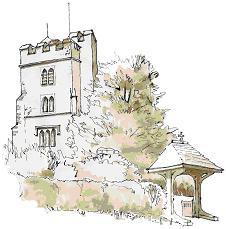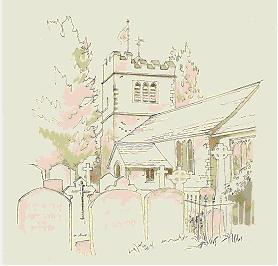 Situated on a former Roman site, the church began in about 1125 as a private chapel built by a Norman Lord, Laurence of Rouen. Roman tiles can be seen in the south wall of the nave, the oldest part of the building. The chancel was added in the 13th century. The first known Rector was Robert de Montfort, 1282 to 1319. For 200 years the church had a Vicar as well as a Rector, the latter usually non-resident. There were also chantry priests for a while to say masses for the dead nobility.
The Church was rebuilt in the 15th and 16th Centuries and the tower as we know it was added. The font dates from this time. At the Reformation under Edward VI the church was stripped of its Roman Catholic ornaments. Samuel Pepys visited the church in 1663 after the Restoration of Charles II but found the sermon boring. Peter Hamelot, a Hugenot from France, was Rector from 1699 to 1742. His tomb lies near the ‘kissing gate’ to the Freeman’s school and was badly damaged in a snowstorm in May 1950. There are several monuments to the Howard family, Lords of the Manor for many years.
 The church was still very plain in 1820, dark and damp like a cellar. A new Rector, The church was still very plain in 1820, dark and damp like a cellar. A new Rector,
the Rev. William Legge, and a caring Lord and Lady of the Manor, Col. and Mrs Mary Howard, transformed the church building between 1820 and 1877 both outside and in. The east window from Liege, the decorated stone reredos behind the altar, the panelled cedar roof of the chancel with the carved angels, the braced beams and roof of the nave, the north transept with its high arch, and the little north aisle with seats facing the pulpit, all of these were the legacy of these three Ashtead benefactors.
In 1873 the 6 bells of 1725 (3 in earlier times) were recast as a peal of 8 in honour of Mary Howard. A new method of ringing, the Ashtead Surprise major, was composed in 1932. The window in the north transept is in memory of William Legge.
In 1891 there was a major restoration. The roof was stripped and renewed, the new organ chamber was built with new arches to the chancel and north aisle, the large choir vestry added in place of a small one, the present oak pews installed and a new pulpit given. There were few changes since then until 1994 when the roof was again stripped and renewed by the same firm who carried out the task a hundred years earlier.
In 2009 was done to the interior of the church to allow access for all. The organ was restored and the windows and monuments cleaned and repaired. Thanks to the generosity of many parishioners the church is ready for use by future generations of worshippers.
Outside there is an ancient yew, possibly denoting a former Saxon church on the site. The churchyard has grown as population increased. 4 ¼ acres were added in 1929, mostly given by the City of London Corporation. The cedars, many of which were lost in the 1987 and 1990 storms, are over 100 years old. The Lych gate was put up in 1903 in memory of Sir Thomas Lucas, former Lord of the Manor. It was restored in 2008 The drive is an ancient right of way to the medieval manor house which stood near the north east corner of the church until about 1800. The church hall is modern.
What is the church?
It is easy to think of it as the building, the bricks and mortar, tastefully constructed for the worship of God. That is partially true. Perhaps, like many people in our modern age, we may think of the Church as a beautiful irrelevance, harmless in its way, but quite out of touch at the start of this fast-moving twenty-first century. There is a real danger that, having looked around our lovely building, that impression could all so easily be paramount in our minds.
The New Testament tells us that the Church is not the building- indeed Christians of the New Testament had no church buildings at all - but a fellowship. It is not a pile of inanimate stone but a fellowship of living people, who have been called to the service of God’s Son, the Lord Jesus Christ.
As you can imagine, we are proud of our ancient Parish Church. We are conscious of its beauty and grateful for the tangible links it provides us with those who have lived, worked and worshipped in Ashtead down the centuries.
Yet we would not want you to go away thinking it is no more than this to us. First and foremost this is the place we come to week by week to worship God, to be restored by him and sent out again joyfully to live our lives as Christians in the community, at work, and at home.
St Giles is the patron saint of Wayfarers. Pause for a moment and enjoy the peace of this church in its beautiful setting and its nearly 900 years of worship.
One can imagine the many hundreds of people from all walks of life who have been baptized in our ancient font; made their Confirmation and Marriage Vows at the entrance to the chancel; listened to words of comfort in bereavement; received the Holy Communion at the altar rail.
Week by week in this church people come and through prayer, music, Bible reading and teaching are inspired to great acts of love and service to our Lord Jesus Christ.
|